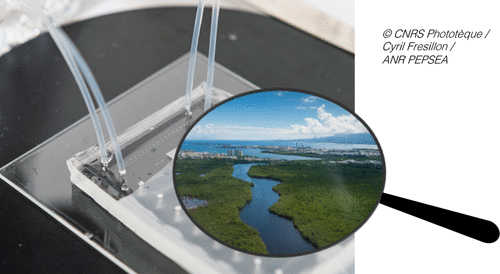当前位置:
X-MOL 学术
›
Environ. Sci. Technol.
›
论文详情
Our official English website, www.x-mol.net, welcomes your feedback! (Note: you will need to create a separate account there.)
Environmental Fate Modeling of Nanoplastics in a Salinity Gradient Using a Lab-on-a-Chip: Where Does the Nanoscale Fraction of Plastic Debris Accumulate?
Environmental Science & Technology ( IF 11.4 ) Pub Date : 2021-02-10 , DOI: 10.1021/acs.est.0c07545 Zélie Venel 1, 2 , Hervé Tabuteau 3 , Alice Pradel 1 , Pierre-Yves Pascal 4 , Bruno Grassl 5 , Hind El Hadri 5 , Magalie Baudrimont 2 , Julien Gigault 1, 6
Environmental Science & Technology ( IF 11.4 ) Pub Date : 2021-02-10 , DOI: 10.1021/acs.est.0c07545 Zélie Venel 1, 2 , Hervé Tabuteau 3 , Alice Pradel 1 , Pierre-Yves Pascal 4 , Bruno Grassl 5 , Hind El Hadri 5 , Magalie Baudrimont 2 , Julien Gigault 1, 6
Affiliation

|
The aim of this study is to demonstrate how the flow and diffusion of nanoplastics through a salinity gradient (SG), as observed in mangrove swamps (MSPs), influence their aggregation pathways. These two parameters have never yet been used to evaluate the fate and behavior of colloids in the environment, since they cannot be incorporated into classical experimental setups. Land–sea continuums, such as estuaries and MSP systems, are known to be environmentally reactive interfaces that influence the colloidal distribution of pollutants. Using a microfluidic approach to reproduce the SG and its dynamics, the results show that nanoplastics arriving in a MSP are fractionated. First, a substantial fraction rapidly aggregates to reach the microscale, principally governed by an orthokinetic aggregation process and diffusiophoresis drift. These large nanoplastic aggregates eventually float near the water’s surface or settle into the sediment at the bottom of the MSP, depending on their density. The second, smaller fraction remains stable and is transported toward the saline environment. This distribution results from the combined action of the spatial salt concentration gradient and orthokinetic aggregation, which is largely underestimated in the literature. Due to nanoplastics’ reactive behavior, the present work demonstrates that mangrove and estuarine systems need to be better examined regarding plastic pollution.
中文翻译:

使用芯片实验室在盐度梯度中的纳米塑料的环境命运建模:塑料碎片的纳米级分数在哪里累积?
这项研究的目的是证明在红树林沼泽(MSP)中观察到的通过盐度梯度(SG)的纳米塑料的流动和扩散如何影响其聚集途径。这两个参数尚未被用来评估胶体在环境中的命运和行为,因为它们无法被纳入经典的实验装置中。诸如河口和MSP系统之类的陆海连续体是影响污染物胶体分布的环境反应性界面。使用微流体方法重现SG及其动力学,结果表明,到达MSP的纳米塑料被分级分离。首先,相当大一部分迅速聚集,达到微米级,主要由正运动聚集过程和扩散电泳漂移控制。这些大型的纳米塑料聚集体最终会漂浮在水表面附近,或者沉降到MSP底部的沉积物中,具体取决于它们的密度。第二个较小的部分保持稳定,并被输送到盐水环境中。这种分布是由于空间盐浓度梯度和原动力聚集作用的共同作用而引起的,这在文献中被大大低估了。由于纳米塑料的反应行为,目前的工作表明,就塑料污染而言,需要对红树林和河口系统进行更好的检查。这种分布是由于空间盐浓度梯度和原动力聚集作用的共同作用而引起的,这在文献中被大大低估了。由于纳米塑料的反应行为,目前的工作表明,就塑料污染而言,需要对红树林和河口系统进行更好的检查。这种分布是由于空间盐浓度梯度和原动力聚集作用的共同作用而引起的,这在文献中被大大低估了。由于纳米塑料的反应行为,目前的工作表明,就塑料污染而言,需要对红树林和河口系统进行更好的检查。
更新日期:2021-03-02
中文翻译:

使用芯片实验室在盐度梯度中的纳米塑料的环境命运建模:塑料碎片的纳米级分数在哪里累积?
这项研究的目的是证明在红树林沼泽(MSP)中观察到的通过盐度梯度(SG)的纳米塑料的流动和扩散如何影响其聚集途径。这两个参数尚未被用来评估胶体在环境中的命运和行为,因为它们无法被纳入经典的实验装置中。诸如河口和MSP系统之类的陆海连续体是影响污染物胶体分布的环境反应性界面。使用微流体方法重现SG及其动力学,结果表明,到达MSP的纳米塑料被分级分离。首先,相当大一部分迅速聚集,达到微米级,主要由正运动聚集过程和扩散电泳漂移控制。这些大型的纳米塑料聚集体最终会漂浮在水表面附近,或者沉降到MSP底部的沉积物中,具体取决于它们的密度。第二个较小的部分保持稳定,并被输送到盐水环境中。这种分布是由于空间盐浓度梯度和原动力聚集作用的共同作用而引起的,这在文献中被大大低估了。由于纳米塑料的反应行为,目前的工作表明,就塑料污染而言,需要对红树林和河口系统进行更好的检查。这种分布是由于空间盐浓度梯度和原动力聚集作用的共同作用而引起的,这在文献中被大大低估了。由于纳米塑料的反应行为,目前的工作表明,就塑料污染而言,需要对红树林和河口系统进行更好的检查。这种分布是由于空间盐浓度梯度和原动力聚集作用的共同作用而引起的,这在文献中被大大低估了。由于纳米塑料的反应行为,目前的工作表明,就塑料污染而言,需要对红树林和河口系统进行更好的检查。



























 京公网安备 11010802027423号
京公网安备 11010802027423号